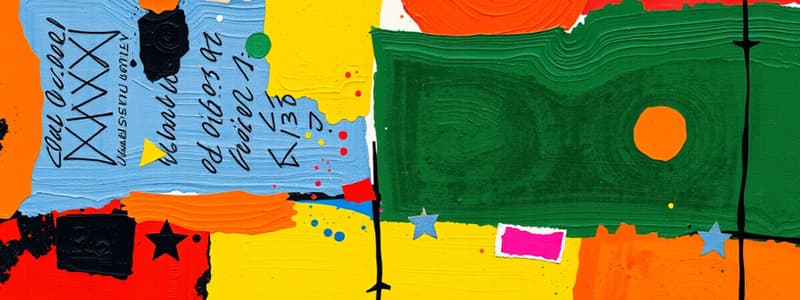Podcast
Questions and Answers
Which line type represents strength and ambition?
Which line type represents strength and ambition?
- Horizontal line
- Diagonal line
- Vertical line (correct)
- Broken line
What is the definition of Integrative Art?
What is the definition of Integrative Art?
- Art that is limited to traditional forms.
- Art that exclusively uses visual elements.
- Art that only involves written forms.
- Art that combines various disciplines and creative processes. (correct)
What type of poem is a Haiku?
What type of poem is a Haiku?
- A poem written in three lines with a total of 17 syllables. (correct)
- A poem composed of four lines with 7 syllables each.
- A poem consisting of 14 lines.
- A poem that spells out a word through its first letters.
What is the primary purpose of the space element in art?
What is the primary purpose of the space element in art?
Which of the following is not a principle of design?
Which of the following is not a principle of design?
What does saturation in color refer to?
What does saturation in color refer to?
Which of the following best describes organic shapes?
Which of the following best describes organic shapes?
What is the relationship between scale and proportion in design?
What is the relationship between scale and proportion in design?
Flashcards are hidden until you start studying
Study Notes
Arts
- Represents the expression of ideas and feelings through creative imagination.
- Originates from the Latin word "Ars," meaning skill.
- Greeks define art as an imitation of reality.
Integrative Art
- Encompasses interdisciplinary art and research.
- Involves the development, presentation, and artistic creation of works.
Visual Arts
- Describes a broad range of artistic disciplines.
- Expresses artistic ideas through images, structures, and tactile creations.
Literary Arts
- Focuses on the expression of ideas through writing.
- Poetry: Structured in lines and stanzas.
- Haiku: A three-line poem with 17 syllables.
- Tanaga: Comprises four lines, each with seven syllables.
- Sonnet: Contains a total of 14 lines.
- Acrostic: The first letters of each line spell out a word or message.
- Prose: Constructed with sentences and paragraphs, lacking metrical structure.
- Drama: Written works that narrate a story.
Performing Arts
- Artistic expression through written lyrics, dramatization, and multimedia.
- Includes various contemporary forms: Literature, Theater, Music, Dance, Architecture, Film, Sculpture, and Painting.
Elements of Arts
- Space: Refers to positive and negative emptiness within artwork.
- Line: Comprised of points, representing various meanings based on orientation.
- Horizontal: Rest and peace.
- Vertical: Strength and ambition.
- Diagonal: Conflict and dynamic action.
- Broken: Indicates hidden aspects from the viewer.
- Shape and Form:
- Shape: Two-dimensional figure defined by connecting line endpoints.
- Form: Three-dimensional, adding volume to the shape.
- Geometric Shape: Defined and measurable shape.
- Organic Shape: Indefinite and free-form shape.
- Color: Relates to natural phenomena, characterized by three properties.
- Hue: Categorized into primary, secondary, and tertiary colors.
- Value: Indicates lightness or darkness.
- Saturation: Refers to brightness or dullness.
- Texture: Pertains to the tactile or illusory surface of the artwork.
Principles of Design
- Scale and Proportion:
- Scale: Comparative size of objects in a design.
- Proportion: Size relationship between parts of an object.
- Harmony: Results when different parts create a cohesive, positive effect.
- Variety: Introduces diverse elements to prevent monotony.
- Movement: Reflects the natural motion of living and non-living things.
- Rhythm: Utilizes repetition to generate patterns within the artwork.
- Emphasis and Subordination:
- Emphasis: The focal point that captures attention.
- Subordination: Elements that support the focal point, contributing to overall impact.
Studying That Suits You
Use AI to generate personalized quizzes and flashcards to suit your learning preferences.




